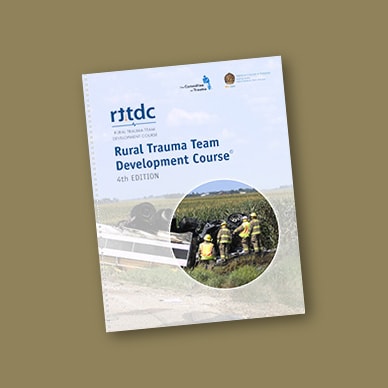Oct. 06, 2018
Trauma professionals often speak of the "golden hour," a 60-minute window for patients to arrive at definitive care, profoundly affecting survival outcomes. Determining how to manage and transfer trauma patients, especially those with physiological indicators of serious injury, is a tall order in a rural setting, perhaps far from larger medical facilities. Deciding whether imaging is appropriate for these patients is a particular concern as additional imaging may actually delay transfer to definitive care.
"It's normal to have a lower comfort level with less experience with seriously injured patients," says James L. Homme, M.D., a Mayo Clinic pediatric emergency medicine specialist, indicating that his hope is to help staff at smaller, rural facilities in decision-making when managing cases they don't see every day.
Role of the Rural Trauma Team Development Course
RTTDC 可以指导医务人员提高专业技能

RTTDC 可以指导医务人员提高专业技能
美国外科医生学院的 RTTDC 向乡村医院的医务人员传授知识,让他们可以依据影像学和其他检查结果对创伤患者作出诊疗决定,并帮助他们通过从多家医院获得的集体经验建立起自己的专业技能。
To address challenges such as whether to image trauma patients, the Rural Trauma Committee of the American College of Surgeons Committee on Trauma developed the Rural Trauma Team Development Course (RTTDC). The course's purpose is to teach staff members at rural hospitals, equip them for decision-making with trauma patients and help them build expertise through the collective experience gained from multiple hospitals.
RTTDC, according to Henry J. Schiller, M.D., a Mayo Clinic trauma surgeon who's served as a course instructor, has led to improved transfer time and transfer coordination in many facilities.
Imaging principles for adult patients
As rural facilities look at the question of imaging trauma patients, Dr. Schiller provides recommendations for the adult population, stemming from his RTTDC experience and years in the trauma field:
Don't delay transfer to obtain imaging that will not change your management.
Dr. Schiller notes that he's observed over time that many smaller hospitals wait to call a higher care level until obtaining a full set of scans for a trauma patient, as hospital staff members feel bad if they don't have all the answers for the patient or receiving hospital. He explains this is unnecessary and that full answers for the patient may take time and possibly delay transfer, and that receiving hospitals don't expect all-encompassing information from transferring facilities.
Full imaging may not be necessary if the patient won't be kept locally.
Rural facilities don't need to take multiple scans if patients are seriously injured and staff knows immediately upon arrival that patients will be transferred, given their status and the hospital's resources. Timeliness in transfer to a higher care level, after initial stabilization and attending to the trauma ABCs, may be the most critical factor in saving a patient's life.
If you need imaging to stabilize the patient, proceed.
In order to stabilize a trauma patient, such as when determining the presence of pneumothorax and relieving lung pressure, imaging is necessary and advisable at times. When no neurosurgeon is locally available, however, obtaining a head CT scan should be left to the receiving trauma center.
Using time for imaging while awaiting emergency transport may be considered.
Dr. Schiller says the traditional answer to the question of conducting imaging while awaiting emergency helicopter transfer has been "Don't bother." However, technology has changed, and Mayo Clinic has upgraded radiologic hardware, unified protocols and set up an outside server for receiving images from other facilities. Therefore, staff at rural hospitals should consider using transport waiting time for imaging, providing transfer is not delayed.
Imaging principles for pediatric patients
While more adult trauma patients are kept at rural facilities, pediatric patients often are transferred to higher care levels where pediatric specialists and equipment are available. Dr. Homme offers input for rural hospitals as they consider imaging for pediatric trauma patients.
Avoid risk overestimation to help alleviate unnecessary imaging.
Accurately assessing trauma patients' risk of serious injury at a facility that may not see similar injuries frequently is a challenge for many rural hospitals. Especially when pediatric patients have not undergone an obviously severe injury, Dr. Homme indicates that determining the child's risk can be a struggle. A correct risk determination can point the direction for the patient's imaging needs. Guidelines for imaging developed through Mayo Clinic Trauma Center are available to aid in decision-making.
Try to limit children's exposure to imaging to restrict lifetime cancer risk.
Due to potential lifetime risk of radiation-related cancer, Dr. Homme advocates judicious use of imaging. Balance the risk of the injury versus the imaging risk. "Pan scans" are often not necessary in pediatric patients, and providers do not need to feel that such scans must be performed prior to determination of the need for transfer.
Use nonimaging assessment tools wherever possible.
Hospital staff with less familiarity with seriously injured patients may be more prone to use imaging rather than observation, says Dr. Homme. Rather than moving quickly to imaging, he suggests a systematic approach to the pediatric trauma patients: Attend to the trauma ABCs, followed by in-depth, head-to-toe examination, while taking into account the child's developmental state when looking for less obvious injuries.
In the stable patient with blunt abdominal trauma, for example, rural facilities can use laboratory tests and serial exams rather than scanning every patient to determine the risk of serious visceral injuries.
Make a phone call if imaging decisions are unclear.
Dr. Homme indicates that he and colleagues regularly field phone calls from rural hospitals related to imaging and other questions. What he does not know, however, is how many don't call.
"Know that resources are a phone call away," he says. "You can call to get another brain and pair of eyes to look at a pediatric trauma patient's status and help you out. We are here as a resource, and we want phone calls and to help from a distance."
For more information
Rural Trauma Team Development Course. American College of Surgeons.